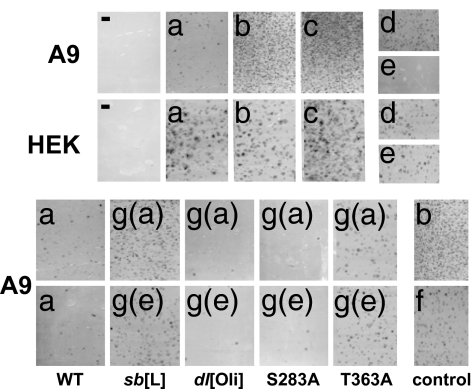Fig. 5.
Cytotoxic activity of adaptor molecules targeting CKIIα activity. Colony-formation inhibition assays are shown. A variety of adaptor constructs were made expressing the TM-interaction domain of NS1 (TR) and either CKIIα- or a CKIIα-binding site (BS, DLEPDEELED) in physically linked or dissociated forms, as WT or mutant polypeptides cloned into pCR3.1 containing the neoR expression cassette. A9 or HEK293 cells transfected with these constructs were tested for the ability to inhibit colony formation in the presence of G418, as visualized by crystal violet staining. (a) TR connected to WT CKIIα. (b) TR linked to dominant-negative CKII(mE81A). (c) GFP-WT CKIIα. (d) TR connected to GFP (without PK). (e) TR connected by GFP to CKIIα-BS recruiting endogenous CKIIα. (f) GFP-BS (GFP with a C-terminal CKIIαBS). [g(a)] Mutated NS1 targeting region (mTR) connected to functional CKIIα. [g(b)] mTR linked to CKIIαBS. The impact of structural elements in TR was investigated by testing the effects of the following mutations: sb[L], methionine-for-leucine substitutions in a leucine (L) stretch; dl[Oli], deletion of the oligomerization signal; S283A and T363A, alanine substitutions at consensus PKC phosphorylation sites.

